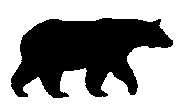The Knowledge We Carry
KC Adams
The Knowledge That We Carry is a digitally accessible Augmented Reality (AR) artwork based on my research with 19th-century Indigenous quilled bags. These bags embody ontological and epistemological understandings, and are functional pieces of art; they are meant to be used, worn and be a carrier of knowledge. In this piece, I am replacing the bag with a commonly used contemporary item––a smartphone. I have pulled components from different quilled bags and reworked the imagery to represent my Inniwew and Anishinaabe teachings on three spiritual realms (sky, earth and underwater) to create an AR digital intervention. My intention is to infuse Indigenous knowledge of interconnectedness for the viewer to consider their relationship to the land, and to counter colonial narratives within public spaces.
For thousands of years, my ancestors, the Inniwew and Anishinaabe people of Turtle Island wore utilitarian objects such as clothing, bags, or ceremonial objects that infused cultural, spiritual, personal, familial, or land knowledge in their thoughtful designs; while these objects were well-worn, there was still an importance around creating everyday objects with care, meticulously designing and embedding a material storytelling. According to Métis scholars Carmen Robertson and Sherry Farrell Racette, from an Indigenous creation aesthetic framework––functionality and spirituality are intimately interrelated (10). It is a source of pride to me that my ancestors cared to build objects for more than just their utility, but to use it to carry forward the knowledge from generation to generation. The design I have created aims to embody the knowledge of interconnectedness using AR on a smartphone––an everyday object equivalent to the ancient bag––and therefore I am following in the footsteps of my ancestors. According to Anishinaabe scholar Niigaan Sinclair, interconnectedness is formed through en-a-wen-di-win (strands connecting all parts of creation) and waa-wi-ye-yaag (interwoven systems of circularity); the two unite to form the law nin-dina-we-maga-nidog (all of my relations) (2). This means that everything within the sky, land, and waters are in relation to each other. The imagery of the AR work wraps around the viewer in waa-wi-ye-yaag to be a reminder of nin-dina-we-maga-nidog.
My interest in leading the viewer towards interconnectedness is to consider the Indigenous space before contact and forge a renewed relationship to land and waters regardless of colonial structural transformations. An example of these transformations is the territory I live in, as we now know as Winnipeg, Manitoba was an important trade route due to many water systems converging together from all directions. Serena Keshavjee talks about the City Beautiful Movement during Winnipeg's economic boom starting in the late 19th century. They were founded on euthenics, believing that environmental planning (such as architecture and transportation mapping) could improve the population's values and well-being (262). The consequence of employing euthenics was the paving over streams and construction of railroads and erections of neoclassical architecture over an important meeting place for many Indigenous nations, shifting the public realm into the private realms. The digital landscape using the AR technology, allows for a reimaging of the public space from colonial infringements to the landscape to a more holistic Indigenous understanding of our relationship to the land within the same spaces: just because a space is urbanized, does not mean that it cannot be Indigenized. We as Indigenous people are part of the present and have found ways to adapt and continue to forge relationships to land in an urban context. Métis scholar Julie Nagam presents the idea that "artworks can narrate stories of place that creatively demonstrate an alternative cartography, one that challenges and contradicts myths of settlement situated in the narratives of colonial archeology and geography" (192). The AR piece overlaps the viewer's location and maps, an alternative Indigenous space to claim the spiritual and cultural knowledge hidden under the colonial settlements. In this work, I attempt to counter settler geological mappings and imagine an Indigenous digital ontological realm. As Haudenosaunee scholar Jolene Ricard explains, every time an Indigenous artist makes an intervention on colonial public spaces, it is a reminder to people about the rich breadth of Indigenous history and knowledge (Nuit Blanche). The Knowledge That We Carry is an imagining of a space that reminds us of how we are connected to one another (the teachings of all my relations) and our relationship to place. The digital landscape of the three realms represented allows Indigenous people to carry the teachings as a visible reminder of the past and a path for their future. As well, non-Indigenous viewers, who are not privy to the knowledge, can reflect and question where they fit within these realms. The digital space can be a powerful tool in reconsidering our physical spaces and have the viewer ponder their positioning in the world around them. Ultimately, when you are invested in a relationship, you are more likely to take care of it.
Works Cited
Keshavjee, Serena. “Modelling Access Through Artistic Intervention in Treaty 1 Territory.” Holding Ground: Nuit Blanche and Other Ruptures, edited by Julie Nagam, and Janine Marchessault, Public Books, 2021, pp. 260-271.
Nagam, Julie. “Disruption Toronto’s Urban Space Through the Creative (In)terventions of Robert Houle.” In Εικόνα Visual Studies Vol 1. Mexico City: SIMO Cultura, 2019.
Nuit Blanche. "Season 1, Episode 2". Unsettling Place: Belonging to a Place, 2, October 2022, https://podcasts.apple.com/ca/podcast/belonging-to-place/id1533749013?i=1000493374241.
Robertson, Carmen, and Sherry Farrell Racette. Clearing a Path: New Ways of Seeing Traditional Indigenous Art. University of Regina, Canadian Plains Research Center, 2009.
Sinclair, Niigonwedom James. "Nindoodemag Bagijiganan: A History of Anishinaabeg Narrative". University Of British Columbia, 2022.

